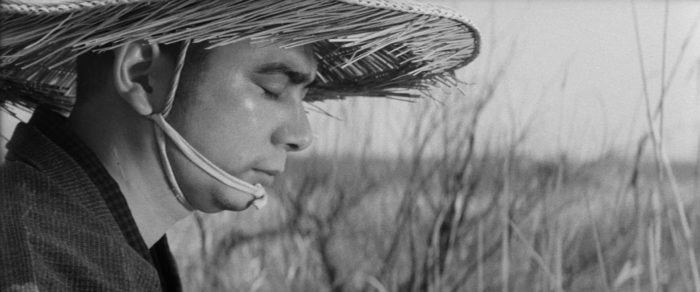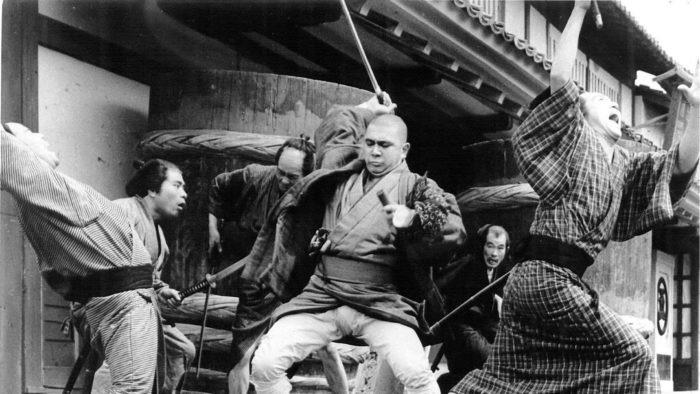
First introduced as a minor character in a 1948 novel by Kan Shimozawa, Zatoichi, The Blind Swordsman, has grown into one of Japan’s most enduring characters. Beginning with The Tale of Zatoichi, Shintaro Katsu would go on to play this role in 25(!) movies between 1962 and 1973, then continue in the TV series (which lasted 100 episodes across four seasons), and finally return to the big screen for one last movie in 1989, which he also directed. It’s hard to think of a Western comparison to that kind of commitment to a role. Katsu made more Zatoichi movies than there are James Bond movies. Like in total. Can anyone else’s time playing one role even compare? I guess some legacy sequels are gonna have bigger time spans, like Dan Aykroyd has also technically been playing Ray Stantz in Ghostbusters movies for 37 years and Nick Castle has been Michael Meyers for 43 years compared to Katsu’s 27 as Zatoichi. Kelsey Grammer as Frasier? Maybe Patrick Stewart as Captain Picard? That’s my best guess, he could have more screentime (178 episodes of TNG, four movies, plus 20 episodes of Picard) over a significantly greater span of time, 36 years (1987-2023). But I don’t think anybody ever played such a concentrated dose of one character. Which begs the question: What makes Zatoichi so special?
Zatoichi’s first cinematic adventure, The Tale of Zatoichi, unlike modern franchise movies, forgoes an origin story and instead does a Yojimbo-type thing where it just lets our wandering hero get involved in some shit and fill in the gaps when necessary. When the movie begins, Ichi — his name is actually just Ichi, the “Zato” part refers to his class, so “Zatoichi” translates to “low-ranking blind person Ichi” — makes his way to a yakuza boss’ compound and quickly hustles a bunch of gamblers who thought they could take advantage of his blindness. Disgusted, Ichi starts to leave but at that moment the boss, Sukegoro (Eijiro Yanagi), returns and convinces Ichi to stay by making one of the gamblers, Tate (Michio Minami) give Ichi, who is ostensibly a masseur, a massage. Sukegoro has seen Ichi’s skills with a sword before and believes he will need his help when war eventually breaks out with the nearby rival yakuza gang. But Ichi seems to just want to take a load off a vibe for a bit. Meanwhile, the other gang’s leader, Shigezo (Ryuzo Shimada), has hired his own muscle: a ronin named Hirate (Shigeru Amachi) who is dying of Tuberculosis.
Ichi doesn’t seem to take the job very seriously — he looks down on the other yakuza’s poor behavior and sees the conflict as unnecessary. He yells at the yakuza and keeps switching between lounging around and being absolutely over this nonsense. He does manage to strike up one friendship, however, with none other than Hirate. The two can recognize the greatness in each other and there is immediate mutual respect. Hirate looks forward to facing Ichi in battle as he’d rather die by the sword than sickness, but Ichi’s increasing resentment for his part in all this causes him to consider just bailing on the whole affair. That’s a great impulse because as tensions rise, we’re also treated to a bummer side plot where Otane (Masayo Banri), Tate’s sister, experiences first hand how shitty these yakuza treat women. When Ichi protects her, Otane falls in love with him and the feelings seem mutual… although Ichi says he’s no good for her. Anyway, as you might imagine, it all comes to a head in the bloody final battle.
One thing that I was surprised to read was that there are serialized elements of the Zatoichi films. The second movie, The Tale of Zatoichi Continues, begins with Ichi returning to visit Hirate’s grave and apparently picking up the Otane subplot, as Masayo Banri is credited in a few of these movies. That sequel, by the way, was released just six months after this first movie; apparently that’s what you gotta do if you’re going to make 25 movies in 11 years, like Marvel did. It looks like 1964 was peak Zatoichi, a record high four movies came out that year. And it’s easy to imagine why they were pumping them out like this: jidaigeki were popular and they really cracked the formula by making their main character such a likable, interesting guy. While other ronin, like Toshiro Mifune’s Sanjuro, would lose some of their cool by prolonged exposure, Zatoichi seems like he could be eternally awesome. It’s right there on the screen: in both his movies, Sanjuro constantly looks like a badass in every single frame, while Katsu’s round features and more naturalistic performance make Ichi seem like an ordinary guy, one who still does have to deal with his limitations from time to time, despite his amazing abilities. He’s a character who can both be the baddest dude around and still have struggles to overcome, which means he’ll be interesting longer than other action heroes who turned into unkillable gods as time weny on, characters like John McClane, John Rambo, John Matrix, John Connor, John Shaft, John Wick and, uh, Johnny English.
The proof is in the pudding: beyond all the Katsu-starring movies, a few other actors have taken a stab at the role: Beat Takeshi made his own version in 2003 and then directed a stage play which itself was made into a movie called Miike Takashi × Aikawa Show: Zatoichi in 2008. That same year, a soft reboot also came out called Ichi, the story of a blind woman who is also named Ichi and was actually a pupil of the original Zatoichi. After that came another movie called Zatoichi: The Last, which, we’ll see about that I guess. And let’s not forget 1989’s Blind Fury, a remake of the 17th Zatoichi film, 1967’s Zatoichi Challenged. That movie starred Rutger Hauer as Nick Parker, which is a really disappointing non-attempt at anglicizing the name Ichi. He’s not even named John! And all that still doesn’t include the mnany, many Zatoichi knock-offs, like the Thundercat Lynx-O or Donnie Yen’s character in Rogue One. In the end, it turns out everybody loves an itinerant badass blind dude.


